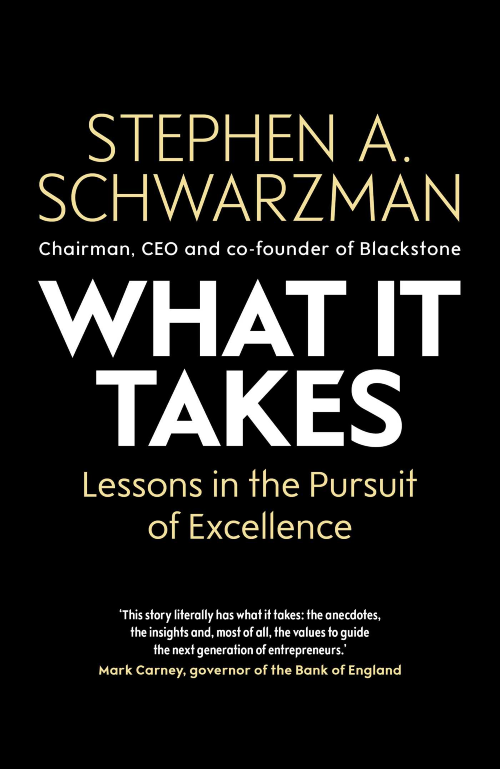Book] Leadership | What It Takes - Stephen Schwarzman
A sharp, leadership-focused summary of 'What It Takes' by Stephen A. Schwarzman — distilling how ambition, judgment, and institutional design create enduring success. Essential reading for finance, policy, and academic leaders building systems that last.
![Book] Leadership | What It Takes - Stephen Schwarzman](/content/images/size/w1200/2025/10/photo-1760464864365-2188cd2afcde.jpeg)

Hi All,
"Never again!"
Stephen Schwarzman once said that a single client experience made him obsessed with pattern recognition, continuous learning, and risk management. I picked up What It Takes by Stephen A. Schwarzman again after hearing it referenced repeatedly in conversations about leadership, scale, and institutional longevity. I first read it when it was published years ago.
Written by the co-founder of Blackstone, it isn’t a victory lap — it’s a meticulous dissection of how world-class leaders think, build, and endure. You might say some sections of the book read more like a Blackstone advertisement than a raw memoir, but if you read beyond the polish, the underlying lessons are gold. This isn’t a personal diary — it’s a masterclass in how to architect an empire by combining technical skill, political intuition, and moral pragmatism.
What struck me while reading was how interconnected these stories of legacy and ambition are in modern finance. If you work in the industry, you probably know that BlackRock got its name from Blackstone — Larry Fink branched out to start his own firm. BlackRock’s former New York office was located right across from Blackstone’s, so I used to walk past their building on my way to work. A few of my friends were (and still are) at Blackstone, and we often discussed ideas about both firms over lunch. (You will be able to see what I mean in BlackStone's 2024 holiday video.)
What I expected was a memoir of financial milestones. What I found instead was a framework for how ambition, systems, and moral judgment intersect to create enduring impact — whether in finance, policy, or philanthropy.
What It’s About: What It Takes chronicles Schwarzman’s journey from a modest upbringing in Philadelphia to co-founding one of the world’s most influential investment firms. Beneath the narrative lies a disciplined playbook for scaling excellence: set audacious goals, hire extraordinary people, institutionalize learning, and make decisions that withstand time.
His core thesis is deceptively simple: “It’s as easy to do something big as something small.” The constraint is rarely capability — it’s vision, courage, and systems that match the ambition.
Executive Summary for Busy People
Great leadership isn’t innate. It’s engineered — through feedback, reflection, and a relentless willingness to stretch beyond the obvious.
Schwarzman’s framework for building lasting success:
- Aim High: Ambition compounds like capital. Small goals rarely attract great people.
- Institutionalize Excellence: Systems, not heroes, sustain performance.
- Decide Decisively: When clarity emerges, act fast. When it doesn’t, wait.
- Protect Reputation: Trust, once broken, takes decades to rebuild.
- Scale Purpose: Wealth without contribution is unfinished work.
How He Built His Kingdom
- Start Early with Relentless Exposure: Schwarzman’s story begins with proximity. He went to Yale, joined Skull & Bones, and sought mentors deliberately. After business school, he joined Lehman Brothers — not by luck, but through persistence and relationship-building. At Lehman, he learned M&A under Pete Peterson. His first lesson: execution matters more than ideas. He watched deals fall apart not because of numbers, but because of human egos and unclear leadership.
- Founding Blackstone — Betting on Scale: When he and Peterson launched Blackstone in 1985, they faced rejection from nearly every institutional investor. They had no track record as a firm, only reputations. Their early vision — a $1 billion fund — was almost absurd for the time. But that scale forced credibility and professionalism from day one. Schwarzman built Blackstone with a simple architecture: keep fixed costs low, partner only with exceptional people, and align incentives around performance. The DNA was clarity and rigor.
- First Setback: Failure of the First Big Deal: Their first proposed investment — a leveraged buyout deal — fell apart. Schwarzman called it “humiliating.” But it forced him to build deeper due diligence systems and to never overpromise.
The setback became a cornerstone lesson: “The best time to learn humility is before the world teaches it to you.” - Institutionalizing Excellence: To prevent those early stumbles from repeating, he created the Monday deal review — where every investment team debated ideas openly. It wasn’t just about deals; it was about building institutional intelligence. This ritual transformed Blackstone from a partnership into a learning machine — a place where insight compounded across teams and years.
- Crisis as Catalyst: Surviving the 2008 Meltdown: By 2008, Blackstone had gone public. The financial crisis hit soon after. Schwarzman became the public face of criticism for private equity excess. But he used the crisis to pivot Blackstone into real estate, credit, and infrastructure — diversifying the business model and future-proofing it.
Instead of retreating, he doubled down on long-term capital and global expansion, opening offices in Asia and the Middle East. - From Capital to Legacy: Beyond business, he focused on building influence through education and policy the Schwarzman Scholars at Tsinghua (a “Rhodes-style” program for China), massive donations to Yale, and roles advising U.S. presidents on economic policy. Love him or not, Schwarzman’s ability to move from boardroom to geopolitical influence is unmatched — driven by his belief that money is a tool for shaping civilization, not an end in itself.
The Leadership Architecture
- Ambition as Design, Not Ego: Think at scale from day one. Blackstone’s $1 billion first fund wasn’t hubris — it was a forcing function for excellence.
- Leaders Are Made, Not Born: Schwarzman obsessively debriefed every failure. Every decision became a case study. Leadership wasn’t instinct; it was built through analysis and repetition.
- Culture as a Competitive Advantage: Monday meetings, brutal debate, zero complacency — Blackstone’s culture made excellence repeatable.
- Trade-Offs & Adversity: Every high-stakes move risked reputation. He learned that good judgment comes from experience, and experience comes from bad judgment.
- Legacy Through Service Wealth as energy: reinvest it into education, global leadership, and policy. Purpose compounds faster than capital.
| Theme | Key Idea | Implication for Practice |
|---|---|---|
| Scale over modesty | Don’t just do the safe thing; reach for audacious goals | Back audacious bets with credibility; push beyond comfort zones |
| “Made, not born” leadership | Excellence is cultivated through relentless learning | Institutionalize feedback loops, study exemplars, reflect often |
| Trade-offs & adversity | Big progress always involves risk, stress, sacrifice | Develop toughness, design for downside protection, align incentives |
| Institutional design & culture | Lasting success depends on systems & people, not just individual brilliance | Build strong processes, hire based on values, embed accountability |
| Decision framework under uncertainty | Move fast when possible, pause when clarity is missing, and act decisively when you see a path | Train judgment, avoid paralysis, commit when the risk-reward is compelling |
| Legacy and purpose | The “why” matters for sustaining drive and influencing others | Invest in causes beyond profit; cultivate meaning through impact |
Evidence-Based Leadership Principles
- Ambition Bias: Big goals attract better people.
- Cognitive Feedback Loops: Review your decisions systematically.
- Trust Velocity: Credibility forms within seconds. Protect it.
- Institutional Memory: Document and debate everything.
- Emotional Endurance: Resilience means staying calm under scrutiny.
Why Technical Excellence Alone Falls Short
Technical brilliance gets you in the room. Emotional intelligence keeps you there.
Schwarzman’s edge wasn’t just IQ — it was composure, judgment, and moral endurance under pressure. He built systems around his weaknesses and surrounded himself with people who could challenge him.
Key Takeaways: The Language and Mindset of Leadership
- Speak in clear, high-definition terms — he avoids jargon and demands simplicity.
- Default to decisiveness — “Do it now” is one of his mantras.
- Build systems of truth — create feedback structures that make excellence inevitable.
- Measure people not by charm but by follow-through.
- Remember: leadership is about clarity, not charisma.
Closing Reflection
Some leaders build wealth. Others build worlds.
Schwarzman did both — through scale, systems, and long-term vision.
What It Takes — it’s part memoir, part manifesto, part branding exercise — but it remains one of the most useful studies in how ambition becomes architecture.
Whether you’re leading an investment fund, a university department, or a public institution, this book is a reminder that greatness is never an accident.
It’s designed — through precision, courage, and service.
🧭 Call to Reflection: Questions to Ask as You Read What It Takes
1. On Ambition and Scale
- Where am I still thinking too small because I’m afraid of being seen as “too ambitious”?
- If I set a 10x goal, what systems and people would I need to support it?
- Am I designing for scale or for safety?
2. On Leadership Formation
- What feedback loops exist in my own career or team? Are they robust enough to make me better each week?
- Do I treat leadership as a fixed identity or a skill I’m still engineering?
- Where have I stopped learning because success made me comfortable?
3. On Decision-Making
- Do I act decisively when clarity appears — or do I overanalyze until the moment passes?
- When uncertainty dominates, do I have the patience to wait for alignment between intuition, data, and timing?
- What’s one recent decision I could have made faster with better preparation?
4. On Systems and Culture
- Does my organization rely on a few high performers, or have we built repeatable systems of excellence?
- How do we capture institutional memory so lessons compound rather than evaporate?
- What rituals—like Blackstone’s Monday meetings—could we formalize to hardwire learning and accountability?
5. On Setbacks and Resilience
- Which past failure taught me my most valuable leadership lesson?
- How do I metabolize failure — defensively, or as data for growth?
- Am I building emotional endurance, or am I mistaking burnout for resilience?
6. On Reputation and Legacy
- How am I protecting my credibility capital?
- When have I made a decision that prioritized integrity over speed or convenience?
- What part of my influence is still transactional, and what part is truly transformational?
7. On Purpose and Impact
- How do I define “enough” — in money, influence, recognition?
- What would it mean to scale not just my business, but my contribution to society?
- If I built something that lasted 100 years, what would I want it to stand for?
Other Resources & References
Stephen Schwarzman: Going Big in Business, Investing, and AI | Lex Fridman Podcast #96: https://youtu.be/aYwDs9LTN50?si=t1eQRQbUZF3e5YSK
Lex and Stephen went deep in this one! Sharing some of the discussions that made a huge impression on me.
Stephen Schwarzman on Entrepreneurship and Life
1. On the entrepreneurial journey
“It’s a rough ride and you have to be psychologically prepared for things going wrong with frequency. You have to be prepared to be put in situations where you’re being asked to solve problems you didn’t even know existed.”
“Everything is new, everything has to be learned… Unfortunately, an entrepreneur starting doesn’t know much of anything.”
2. On not being alone
“It’s important not to be alone because it’s sort of overwhelming, and you need somebody to talk to other than a spouse or a loved one—because even they get bored with your problems.”
“Getting a group… people who can give advice, share situations to talk about—that’s really important.”
“Most people who haven’t had experience believe in the myth of the one great person who makes outcomes. It’s mostly a myth. This is a team sport.”
3. On failure and self-criticism
“Most entrepreneurs at some point question what they’re doing because it’s not going so well, or they’re screwing it up and they don’t know how to unscrew it up.”
“It’s hard to be learning when there are like 25 variables going on—and if you’re missing four big ones, you can really make a mess.”
4. On love, family, and friendship
“Ultimately all journeys are alone. It’s great to have support… you’re going to need support, and you’re going to have to have people involved with your life who understand that that’s really part of your life.”
“People don’t become successful as part-time workers—it doesn’t work that way. If you’re prepared to make that 100 to 120% effort, you’re going to need support.”
“Sometimes you’re involved with somebody and they don’t really understand that, and that’s a source of conflict and difficulty. But if you’re involved with the right people, you have to involve them in your life—but not burden them with every minor triumph or mistake.”
5. On protecting relationships
“I tell people with their first child or two children—it’s important to go away with your spouse at least once every two months. No children, no issues. Sometimes once a month if you’re energetic and clever.”
“You have to escape the craziness of it all and reaffirm your values as a couple. You have to have fun. If you don’t have fun with the person you’re with, and all you’re doing is dealing with issues, that gets pretty old.”
“You have to protect the fun element of your life together… you have to get away and reinvigorate your relationship.”
6. Closing words (from What It Takes)
“It’s as hard to start and run a small business as it is to start a big one. You will suffer the same toll financially and psychologically as you bludgeon it into existence.”
“It’s hard to raise the money and to find the right people. So if you’re going to dedicate your life to a business—which is the only way it will ever work—you should choose one with the potential to be huge.”
Bonus
Bookmark this. If you are also like me who likes to be inspired by watching leaders' interviews and stories, please check out my hand curated interview list. It's available as a Notion notebook. Worth a Read/Watch/Listen - Leadership

Who are the leaders who inspire your definition of character and success? I’d love to hear your thoughts.

![Finance | Leadership] How I Built a Global Career in Finance: A prelude to the upcoming series: Breaking Into Finance](https://images.unsplash.com/photo-1676471049029-f93852da351d?crop=entropy&cs=tinysrgb&fit=max&fm=jpg&ixid=M3wxMTc3M3wwfDF8c2VhcmNofDl8fG1vdW50YWluJTIwZXZlcmVzdHxlbnwwfHx8fDE3NjQwNTgyMjB8MA&ixlib=rb-4.1.0&q=80&w=720)
![Obsidian Memo | Culture Shocks] From Seoul to Toronto to New York to London: A Life in Translation](/content/images/size/w720/2025/10/Emily-in-Paris.jpg)
![Obsidian Memo] When “The Diplomat” Made My Life Make Sense](/content/images/size/w720/2025/10/diplomat_ver2_xlg--1-.jpg)